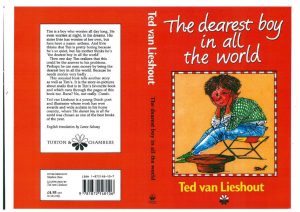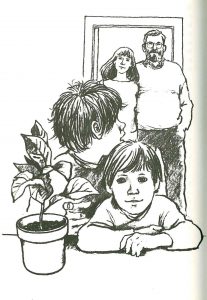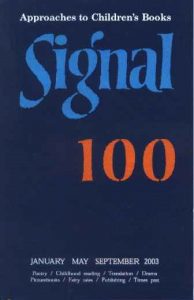In 2016, Seven Stories: The National Centre for Children’s Books acquired the prestigious archive of Aidan and Nancy Chambers as part of the Heritage Lottery Fund’s Collecting Cultures project. In doing so, it gave a home to one of the most important British children’s literary archives in the country. In this blog post, Newcastle University Research Associate Dr Hazel Sheeky Bird, who is working on opening up new research avenues into the collection, supervised by Dr Lucy Pearson, explains the background to this archive.
Featured image: 10th anniversary of Signal – 1980 Patrick Hardy, Aidan and Nancy Chambers, Lance Salway and Elaine Moss (from left to right)
The range of material held in the Chambers archive is truly impressive, hardly surprising given the contribution that both Aidan and Nancy Chambers have made to the fields of children’s and young adult fiction, literary criticism, publishing and education. Thanks to a grant from the Archives Revealed Scheme (funded by the National Archives and The Pilgrim Trust), research supported by Newcastle University’s Children’s Literature Unit and the ongoing commitment and expertise of the Seven Stories Collection team, the Chambers archive will soon be available for use.
In 1969, Aidan and Nancy Chambers established Signal: Approaches to Children’s Books (1969-2003), one of the first journals dedicated to children’s literary criticism and home to the Signal Poetry Award (1979-2001). Through their own Thimble Press, they also published highly influential works of children’s literary criticism, invaluable guides to the best books for children, and Aidan Chambers’ seminal works of children’s literary criticism (‘The Reader in the Book’ [1977]) and on education (The Reading Environment [1991], Tell Me: Children, Reading and Talk [1993]). Added to this is Aidan Chambers‘ work as editor of ground-breaking YA MacMillan Education imprint, Topliner (1968-1980), his own award-winning ‘Dance Sequence’ of young adult novels as well as books for younger readers, and his work as editor of Turton & Chambers, an independent publishing house dedicated to publishing books in translations. What becomes clear on delving into the archive is the richness of the material and the wealth of opportunities it offers researchers.

Let’s take the Turton & Chambers (T&C) material as a quick example. Beginning in 1989, this was a co-equal venture between David Turton, owner of The Singing Tree children’s bookshop in Perth, Australia and Aidan Chambers: Turton provided the finances and Chambers the editorial expertise. According to T&C’s promotional material, their aim was to ‘publish the rare, the unusual, the extraordinary, the refreshing’ (Company Notice, T&C, Books for Young Readers, Aidan and Nancy Chambers archive, Box A, file 11, p.2.). Books that, for Chambers, allowed readers to ‘extend their range of thinking, their imagination’ (Niki Kallenberg, ‘Features: Publishing the kind of book I wish I’d written’, Scan, 9(3), June 1990, 4-9 [p. 5]) in a way he thought was impossible in their own language. Over the course of three years, T&C published 16 books, mostly prose, translated from French, German, Swedish, Norwegian and Dutch. Many T&C authors, such as Maud Reuterswärd (A Way from Home (1990), Noah is my Name (1991), both translated from the Swedish by Joan Tate, Tormod Haugen (Zeppelin (1990), translated from the Norwegian by David R. Jacobs) and Peter Pohl (Johnny, my friend (1991), translated from the Swedish by Laurie Thompson), were all award-winning novels either in their country of origin or in Europe. Sometimes stylistically challenging, often unusual and innovative, always thought provoking, the T&C list remains relevant and genuinely engaging for readers of all ages.

Aidan Chambers’ correspondence with Anthea Bell, perhaps best known for translating René Goscinny and Albert Uderzo’s Asterix books, offers fascinating insights into many aspects of their work and lives. Letters illuminate the relationship between translator and editor, the practicalities and realities of working as a translator, and the nuanced and detailed discussions that took place between Chambers and his translators to ensure work of the highest quality. Letters also reveal the warm relationship between Aidan Chambers and Anthea Bell. Writing to Bell on 13th July, 1989, Chambers describes the ‘nerve-wracking’ process of bringing two books to print ‘without the support of a design department’ and comments that despite any resulting shortcomings, ‘at least the books will come from strong personal commitment and extraordinary good will and generosity from those like yourself who have helped with translation and editorial work’ (Box A, file 1).

Happily, the T&C archive has been examined and catalogued as part of a bigger project to fully catalogue the Aidan and Nancy Chambers archive, which will take place over the next 18 months. Work is now underway cataloguing the material for the 100 editions of children’s literature journal Signal, edited by Nancy Chambers. Taking up almost 30 archive storage boxes, the team has begun to weed, process and re-package the material, prior to creating the catalogue. This is a delicate process: a balance has to be found between preserving materials that clearly demonstrate the production processes of the journal with the demands on storage space, the research value of the material, and the ease of use for future researchers. Added to this, is the need to condition check all material prior to re-packaging to ensure that no unwanted substances, i.e. dreaded mould, are transferred into the Collection. All of this adds up to slow and careful work: the weeding process alone will take two months.
The end result will be worth it. Enquiries are already coming in from researchers keen to access the Chambers archive and the team is working hard to get the material ready for them.
Thanks Hazel! We’ll look forward to hearing more about what you’re discovering in the Chambers Collection as your project progresses.


